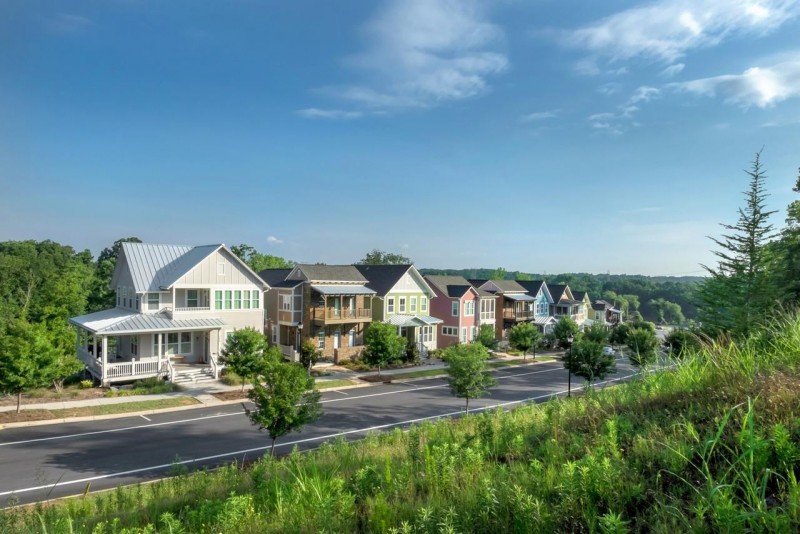A Public-Private Partnership (PPP or P3) is a government or private venture which is funded and operated through a contractual agreement between a public agency (federal, state, or local) and a private sector entity.
Why is this important to your community?
Infrastructure is essential to support healthy, well-functioning communities within the CONNECT region. According to the 2013 Report Card for America’s Infrastructure, a report issued by the American Society of Civil Engineers every four years to grade infrastructure quality in the U.S., the cumulative grade for infrastructure in the country is a “D+.” Infrastructure categories include aviation, bridges, dams, drinking water, energy, hazardous waste, inland waterways, levees, ports, public parks and recreation, rail, roads, schools, solid waste, transit, and wastewater. The individual infrastructure assessment for North Carolina concluded that 45% of major roads are of poor or mediocre quality and that there are 2,192 structurally deficient bridges and 1,255 high hazard dams in the state. Similarly, South Carolina’s infrastructure assessment revealed that 40% of major roads are of poor or mediocre quality and that there are 1,141 structurally deficient bridges and 204 high hazard dams. Outdated and deficient infrastructure represents a real cost to local governments and residents of communities within the CONNECT region. The study estimates that the poor quality of major roads in the state costs motorists in North and South Carolina $241 and $255 per year, respectively. Additionally, North and South Carolina will need an investment of $10 billion and $1.6 billion, respectively, to maintain and upgrade existing drinking water systems over the next 20 years. Given the extent of investment needed to update existing infrastructure, forging public private partnerships is one tool local governments can use as an alternative approach to funding necessary infrastructure in lieu of sufficient funding from federal or state agencies.
Skip directly to
How Does It Work?
Resources
Using the Tool
Partners
Where Has It Worked?
Where is it appropriate to use?
What priorities does it address?
What other tools are related?
- Capital Improvements Programming
How does it work?
Public-Private Partnerships (P3s) are contractual agreements between public and private entities. Entering into a P3 allows public entities to undertake projects that they would otherwise not have funding to complete. P3s can often result in greater efficiency and even reduce the burden placed on taxpayers to pay for necessary infrastructure and other projects (e.g., renewable energy production, parks and trails etc.) by not adding to the public debt. Many states, including North and South Carolina, have legislation in place that enables public entities to enter into P3s to fund infrastructure projects. There are many types of P3 agreements ranging from Operations and Maintenance to Design-Build. Depending on the scale and scope of the project, a public entity may choose to retain ownership and management while the private partner designs and builds the project or a public entity may lease or purchase a new facility from their private sector partner after construction. Regardless of the scale of a project, the benefits of P3 agreements include the ability of finance important infrastructure projects in challenging economic times, improved benefits for private sector workers, and the ability to improve road safety and provide clean water. According to the National Council for Public-Private Partnerships, there are 7 keys to success for P3s.
- Public Sector Champion – make sure that public sector representatives communicate the benefits of a P3 to the public.
- Statutory Environment – P3s are generally more successful in states or localities with legislation that supports P3s.
- Public Sector’s Organized Structure – a dedicated public sector team to implement P3 projects to evaluate new proposals and monitor the execution of existing P3s.
- Detailed Contract (Business Plan) – a clear contract delimitating responsibilities for both public and private sector partners ensures that both parties understand the risk and benefits of a partnership and will contribute to the success of the project.
- Clearly Defined Revenue Stream – before executing any partnership, ensure that there will be an acceptable return on investment for both partners.
- Stakeholder Support – communicate all of the risks and benefits of creating a P3 to the public and other stakeholders (e.g., employees, labor unions, and other relevant groups)
- Pick Your Partner Carefully – ensure that private sector partners are financially solvent and invested in the success of the potential P3.
While P3s are generally contractual agreements, other forms of Public-Private Partnerships may involve informal or formal agreements between public sector and community partners (e.g., non-profit and faith-based organizations, neighborhood associations, and community development groups). These partnerships do not necessarily tackle large infrastructure projects. Instead, they often work on smaller, neighborhood or community-based projects like streetscaping, community gardens, parks, home energy improvements, and other improvements and rely on volunteer time and donations.
Ready to get started?
Using the Tool
- Meet with representatives from municipal departments (those that handle development, planning, infrastructure, and funding) and potential private sector partners (including private companies and non-profit community partners).
- Research and discuss existing Public-Private Partnership (P3) legislation, including local government procurement laws in your state (see North and South Carolina legislation). Having the correct legislative base that allows for the formation of P3s is a key to success. Consider noting any potential amendments to existing legislation.
- Create a priority list of potential projects and sites that may benefit from a P3 and a list of private sector partners to consider.
- Form a public sector team dedicated to developing proposals for P3s. Research P3 unit models at the state, county, or municipal level. One option could be Canada’s P3 model (see Why Isn't the U.S. Better at Public-Private Partnerships?). This model resulted in the formation of Partnerships British Columbia in 2002 to help finance infrastructure in difficult economic times. Partnerships is a company, not a government agency, that acts as a consultant by providing advice to the province. The company analyzes potential P3 contracts, assists in planning, selects bidders, and helps implement P3 agreements. Since opening the Partnerships office, the province has noted an increase in the success of P3s (e.g., projects end on time, budgets are accurately estimated, etc.).
- Work from the priority list of projects and potential partners and form a P3.
- Draft a detailed contract or business plan that clearly lays out the responsibilities for both parties.
- Define how the project will function when finished. What is the return on investment for both private and public sector parties, how will income be generated? Income could come from a variety of sources including, tax incentives, tolls, fees, rent payments, etc.
- Engage stakeholders (private companies, employees, and residents) throughout the process from design to construction; ensure that all interested parties understand the project’s value to the public.
- Support P3s by ensuring that the public understands the value of these partnerships (e.g., increased efficiency, well-functioning infrastructure, job creation, possibility of reduced taxes, etc.). This may include a public support campaign, community-wide meetings, or print and web-based materials.
Partners
- Community Development Organizations
- Community Service Providers
- Construction Companies
- Developers
- Economic Development Organizations
- Elected Officials
- Faith-Based Organizations
- Health Care Providers
- Housing Authorities
- MPOs, RPOs, and COGs
Where has it worked?
RiverWalk - Rock Hill, SC
 Image Source: Evans Coghill Homes.
Image Source: Evans Coghill Homes.
Contact
Stephen Turner
City of Rock Hill, SC
stephenturner@cityofrockhill.com
803-329-7097Dave Williams
The Assured Group
dwilliams@assuredllc.com
803-324-7762About the Program
RiverWalk is a $600 million multi-use development along the Catawba River in Rock Hill, South Carolina. The development was planned and completed through a Public-Private Partnership between the City of Rock Hill and Assured Group. RiverWalk, located on a 1000-acre brownfield the former site of the Celanese chemical plant, consists of a variety of housing (over 3,000 residential units), a business district, manufacturing, sports facilities, open spaces, and miles of biking trails. The new development provides a multitude of publicly assessable amenities to Rock Hill residents. The Rock Hill Outdoor Center (RHOC) adds more than 250-acres of new public recreation space to the city’s existing park system, including a new YMCA, athletic fields, trails and new streets, 2.5 miles of new river frontage, canoe/kayak launch areas, and the Giordana Velodrome (a world-class Olympic and professional cycling training center). The City of Rock Hill provided funding for initial public improvements including the Riverwalk Trail and the RHOC and provided creative financing tools for Assured Group (the developer) at an estimated cost of over $53 million. The Assured Group provided guarantees of payment using the land as collateral ($40 million estimated value) and provided construction services. A Tax Increment Financing (TIF) district which provided $10 million in city-backed bonds and up to $5 million in developer-backed bonds and a Municipal Improvement District (MID) were created. The MID creates a district that allows the city to collect additional tax assessments to fund bonds. The P3 contract for RiverWalk included strong security and payment guarantees by the developer, gave the city a greater interest in the case through the creation of the MID, and gave the city the right to foreclose on the property. In addition to creative financing provided to the developer, the city utilized New Markets Tax Credit Loans and Federal Recovery Zone Facilities Bonds to finance part of the RHOC.
Why it works
The RiverWalk development is an example of a Public-Private Partnership between the city and a developer that provides benefits to residents of Rock Hill, a consistent revenue stream for the city through tax assessments, and provides the developer with a return on investment. The RHOC, new residential homes and apartments, and Business Park, will create 4,000 potential jobs, provide the city with $375,000 per year in hospitality tax revenues, draw new investment, and provide $20 million per year in property taxes and utility revenues. The 2.5 mile RiverWalk Trail, part of the Carolina Thread Trail System, receives 9,000 visitors per month, which is expected to increase as more residential units and apartment buildings are constructed.
http://www.carolinathreadtrail.org/wp-content/uploads/2011/12/If-We-Build-It-Will-They-Come.pdf
http://www.rockhillusa.com/news/post/41/riverwalk-helps-rock-hill-earn-national-award
http://www.riverwalkcarolinas.com/cyclingoutdoors/rock-hill-outdoor-center/
http://www.landdesign.com/Libraries/Experience_Books/LandDesign_505_Book.sflb.ashx
- Community Service Providers


